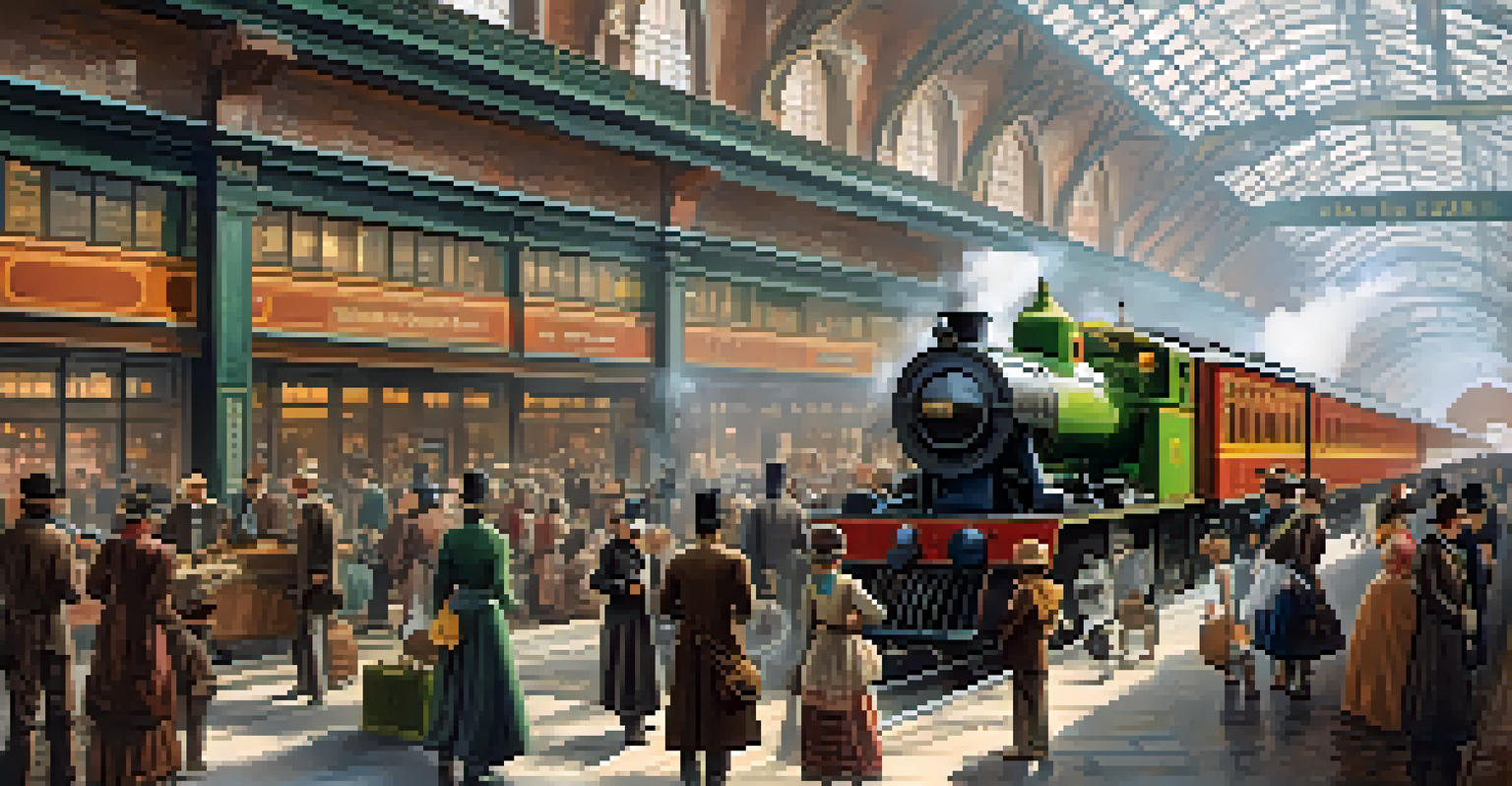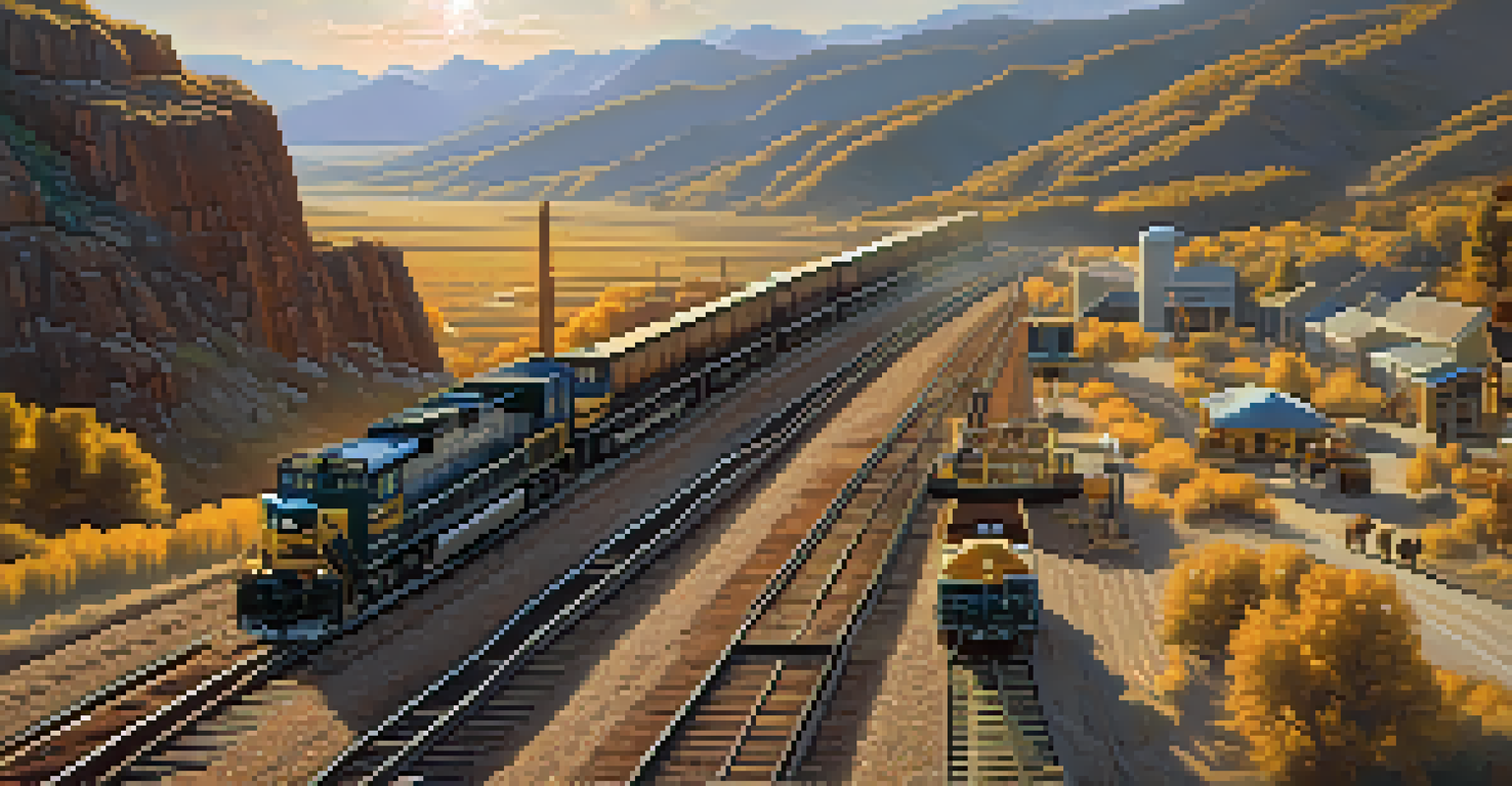The Transcontinental Railroad: Connecting Coasts and Cultures

The Vision Behind the Transcontinental Railroad
The Transcontinental Railroad was born from a bold vision to connect the East and West coasts of the United States. This monumental project aimed to facilitate commerce and travel, making it easier for people and goods to move across the vast country. The dream was not just about railways; it was about uniting a nation that was rapidly expanding and diversifying.
The railroad is a great social and economic force, and it has brought about the most important changes in the land and the people who inhabit it.
In the mid-19th century, the idea gained traction as the Gold Rush drew thousands to the West. People envisioned a railway that would not only transport gold but also connect families, communities, and cultures. This vision inspired lawmakers and investors to support a project that would change the American landscape forever.
Ultimately, the need for a faster, more efficient means of transportation fueled the passion behind the project. The Transcontinental Railroad was a solution to logistical challenges and a symbol of American ingenuity and determination.
The Journey of Construction: Challenges and Triumphs
Constructing the Transcontinental Railroad was no small feat; it required immense resources and human labor. Workers faced harsh weather conditions, treacherous terrains, and limited supplies as they laid tracks across mountains and plains. The challenges were daunting, but the determination to succeed drove the workforce forward.

One of the most significant obstacles was the Sierra Nevada mountain range. Engineers had to devise innovative solutions, such as creating tunnels, to navigate the rugged landscape. It was a true test of human perseverance, with workers risking their lives to complete this monumental task.
Uniting the Nation through Connectivity
The Transcontinental Railroad was a monumental project that connected the East and West coasts, facilitating commerce and travel while uniting a rapidly expanding nation.
Despite setbacks, the construction of the railroad showcased remarkable teamwork and resilience. The completion of the project signified not only a physical connection between coasts but also a triumph of the human spirit in overcoming adversity.
Cultural Exchange: A Melting Pot of Ideas
The Transcontinental Railroad did more than just connect two coasts; it facilitated a rich exchange of cultures and ideas. As trains traveled from one coast to the other, they carried people from diverse backgrounds, creating a melting pot of traditions and practices. This cultural exchange fostered a sense of unity among the nation's inhabitants.
The Transcontinental Railroad was a remarkable achievement, not just in engineering but in bringing together the diverse cultures of America.
Travelers on the railroad shared stories, foods, and customs, enriching the American cultural landscape. For instance, Chinese laborers played a crucial role in building the railroad, bringing their culinary delights and traditions, which still influence American cuisine today. Such interactions helped to break down cultural barriers and promote understanding.
The railroad became a symbol of collaboration, where different communities came together for a common purpose. This merging of cultures set the stage for future interactions, shaping the social fabric of the United States.
Economic Impact: Boosting Growth and Trade
The economic implications of the Transcontinental Railroad were profound. It opened up new markets and created opportunities for trade, enabling goods to flow freely between the East and West. This connectivity transformed local economies, allowing businesses to thrive and expand beyond their immediate surroundings.
With the railroad in place, agricultural products from the West could reach consumers in the East much faster. Similarly, manufactured goods could be shipped to the West, supporting burgeoning industries and improving living standards. This economic boom was a direct result of the railroad's ability to streamline transportation.
Cultural Exchange and Diversity
The railroad fostered a melting pot of cultures and ideas, enriching American society through shared traditions and interactions among diverse communities.
Moreover, the railroad led to the establishment of new towns and cities along its route. These communities often sprang up around depots, becoming hubs of commerce and culture, further enhancing the nation's economic landscape.
Challenges Faced by Indigenous Peoples
While the Transcontinental Railroad brought benefits to many, it also had a devastating impact on Indigenous peoples. The construction and expansion of the railroad disrupted their traditional lands and ways of life. Many Native American tribes faced displacement, as their territories were traversed and altered by the expanding rail network.
As settlers moved westward, the promise of land and opportunity often came at the expense of Indigenous communities. Conflicts arose, leading to loss of life and culture as tribes fought to protect their heritage. The railroad, while a symbol of progress for some, represented a significant loss for many others.
Today, the legacy of the Transcontinental Railroad serves as a reminder of the complex history of America. It highlights the need for acknowledgment and reconciliation with Indigenous peoples who were profoundly affected by this monumental project.
Technological Innovations: Engineering Marvels
The construction of the Transcontinental Railroad spurred a wave of technological innovations that transformed the engineering landscape. From improved steam engines to advanced track-laying techniques, the project pushed the boundaries of what was possible at the time. Engineers and laborers employed creative problem-solving to tackle the challenges posed by the diverse American terrain.
One notable innovation was the use of the telegraph, which allowed for real-time communication between crews working on different segments of the railroad. This technology significantly improved coordination and safety, showcasing how interconnected advancements could facilitate large-scale projects.
Economic Transformation and Growth
By opening new markets and streamlining transportation, the Transcontinental Railroad significantly boosted trade, allowing local economies to thrive and evolve.
The engineering feats achieved during the construction of the railroad laid the groundwork for future infrastructure projects. The legacy of these innovations continues to inspire modern engineering, emphasizing the importance of creativity and collaboration.
The Legacy of the Transcontinental Railroad
The Transcontinental Railroad remains a powerful symbol of connectivity and progress in American history. Its completion marked a significant milestone, uniting the nation and paving the way for further expansion and development. The railroad not only changed the way people traveled but also reshaped the American identity.
Over the years, the railroad has left an indelible mark on the economy, culture, and landscape of the United States. It serves as a reminder of the complexities of progress, including the sacrifices made by countless individuals and communities. Today, we can reflect on both the achievements and the challenges that accompanied this transformative project.

As we celebrate the legacy of the Transcontinental Railroad, it urges us to continue fostering connections and understanding among diverse cultures. The spirit of collaboration that built the railroad can inspire us to work towards a more inclusive future.